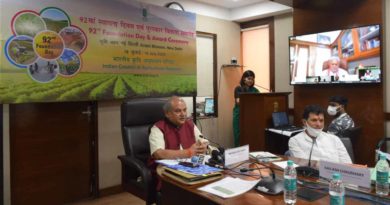Cotton in North India is suffering because of excess water and in the South because of less water: Dr. CD Mayee
17 April 2023, Punjab: “There is a need to speed up the process of varietal development, especially, the hybridization program of cotton by placing focus on Bt gene, large boll size, resistance towards diseases, and mechanical harvesting,” emphasized Dr. TR Sharma, Deputy Director General (Crop Sciences), Indian Council of Agricultural Research (ICAR), New Delhi while inaugurating the two-day Annual Group Meeting 2022-23 of All India Coordinated Research Project (AICRP) on Cotton at Punjab Agricultural University (PAU) today. Delegates from various State Agricultural Universities and ICAR institutes as well as agricultural experts from PAU attended the inaugural session.
Calling Universities important channels of releasing technologies to the farmers, the ICAR expert stressed upon enhancing farmers’ income through cotton lint or edible oil seeds. “Since its introduction in 2002, Bt cotton is playing a very important role, and efforts need to be made to popularise Bt cotton varieties/hybrids and develop technologies for cotton improvement,” observed Dr. Sharma. Pointing out the issue of low cotton production and productivity, Dr. Sharma assured of releasing a few varieties for High-Density Planting System (HDPS).
Dr. CD Mayee, Former Chairman of the Agricultural Scientists Recruitment Board, who worked at PAU also 50 years back, underlined the need for integrating private companies with Universities for the development of Bt cotton hybrids. “Cotton in North India is suffering because of excess water, while in South India, it is suffering because of less water,” he observed while calling for addressing the problem of waterlogging in cotton cultivation. Impressing upon the development of HDPS hybrids of cotton, Dr. Mayee reiterated the integration of public-private partnerships in this direction.
Dr. RK Singh, Assistant Director General (Commercial Crops), ICAR, New Delhi, lauded the success of the Integrated Pest Management (IPM) program in curbing the whitefly menace in North India and the rising interest of the Ministry of Textiles in cotton cultivation.
Expressing concern over the issue of florescence being faced by the Spinning industry, Dr. SK Shukla, Director, ICAR- Central Institute for Research on Cotton Technology, Mumbai, told that it was due to the wanton use of pesticides. He also raised concern over the difficulties cropping up during cotton harvesting and called upon the breeders to come up with HDPS hybrids as a solution for the same. Dr. Shukla also discussed in detail the fiber quality of cotton and the parameters being followed by the Spinning industry.
Dr. YG Prasad, Director, ICAR-Central Institute for Cotton Research, Nagpur, said: “Cotton is a cash as well as commercial crop combating the pressing challenge of the climate crisis. The year 2019-20 saw excellent results in cotton cultivation, but the year 2021-22 saw a lot of destruction. This year (2022-23) again, challenges are cropping up in cotton productivity.” Stating that whitefly was the biggest challenge, he extolled the efforts of the cotton researchers and the extension specialists in tackling this problem in North India. Dr. Prasad also voiced concern over the challenge of Pink Bollworm management in the Central, North, and South zones and urged the experts to step up the efforts in this regard as well as for the monsoon deficit.
Dr. Rathinavel, Project Coordinator, ICAR-AICRP on Cotton, while presenting the highlights of the report, told that India, Bangladesh, Egypt, and Pakistan were the largest consumers of cotton. He also referred to various cotton varieties and hybrids, and the area under this crop in Punjab, Maharashtra, Rajasthan, Gujarat, etc.
Earlier in his welcome address, Dr. AS Dhatt, Director of Research, divulged that India was the largest producer of cotton, but the crop was sensitive to biotic stresses. The intervention of Bt cotton has been a breakthrough, he said, while informing about the provision of a seed subsidy of 33 percent to the cotton growers of Punjab in the current crop season. Although whitefly wreaked havoc for the cotton growers in 2015, the collective efforts of researchers, extension workers, and administrators successfully contained this pest, he added.
Also Read: Tractor sale in India crosses 8 lakh mark
(For Latest Agriculture News & Updates, follow Krishak Jagat on Google News)















